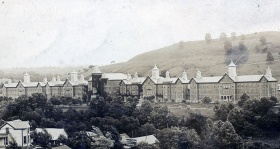Kirkbride Planned Institutions
The Kirkbride Plan is a 19th century building style that is the direct result of Dr. Thomas Story Kirkbride. Early in his career as superintendent of the Institute of the Pennsylvania Hospital he wrote a book titled: On the Construction, Organization and General Arrangements of Hospitals for the Insane. Within his book he espoused an architectural design for the hospital, administration of said asylum, placement of the hospital, and how the hospital grounds should be created and maintained.
A Kirkbride Plan building consists of a center section for the hospital administration and (in the early days) a living area for the superintendant and his family. Behind and to either side of the administration section are "wings" that contain patient wards. The patient wards staggered out and back from the administration section. From the air the building would look like a "V" or a "bat wing". Chapels, auditoriums, libraries, and kitchens were often built directly onto the rear of the administration section as this was a convenient, central location for these facilities since the male and female patients resided on opposite sides of the building. The Kirkbride Plan allowed for many other advantages over previous building styles. It allowed for maximum amounts of light and ventilation into the patient wards. It allowed for easier arranging of patients by type, typically the noisier and more uncontrollable patients were placed in the wards farthest from the administration section. It also allowed for easy expansion of the hospital, additional wards could be built onto the ends of the existing building without disrupting daily life at the hospital. Kirkbride Plan buildings tended to become large, imposing, Victorian-era institutions, between 3-5 stories tall, built on large extensively manicured grounds which often included farmland.
Completed in 1854, the Taunton State Hospital in Massachusetts became the first hospital built following the kirkbride plan. The slow demise of these institutions came about with a combination of the death of Dr. Kirkbride in the late 1880's and a shift in popular treatment methods for the insane. Around 1900 most new hospitals were moving away from the Kirkbride Plan in favor of smaller and more segregated styles of asylum construction. Many kirkbride buildings were lost in the 20th century due to fires, others were abandoned or demolished when newer buildings were constructed. Some have been modified so heavily that they no longer look like a kirkbride building. There are however, still a few Kirkbride buildings that have survived into the 21st century, some are still being used for their original purpose, others have been renovated for other uses like residential housing.
There are predominately two types of Kirkbride Plan hospitals, traditional and modified. Below are some key features and examples of each type.
Traditional Kirkbride
- Tightly grouped wards.
- No exterior porches.
- Compact over all design.
- Influenced by AMASII patient limitations of only 250 patients.
- Proper ventilation and design in accordance to the building plan by Dr. Thomas Kirkbride.
- Continuous foundation and roof line.
Modified Kirkbride
- Wards are more spaced out and may be connected by single or multistory hallways.
- Buildings have become more ornate.
- Open air porches attached to wards.
- Buildings are generally larger and can hold up to 600 patients due to changes by the AMASII in 1866.
- Buildings don't conform completely to the building plans specified by Dr. Thomas Kirkbride.
- Buildings may only be half built, or modified to allow for building constraints of the area or land.






